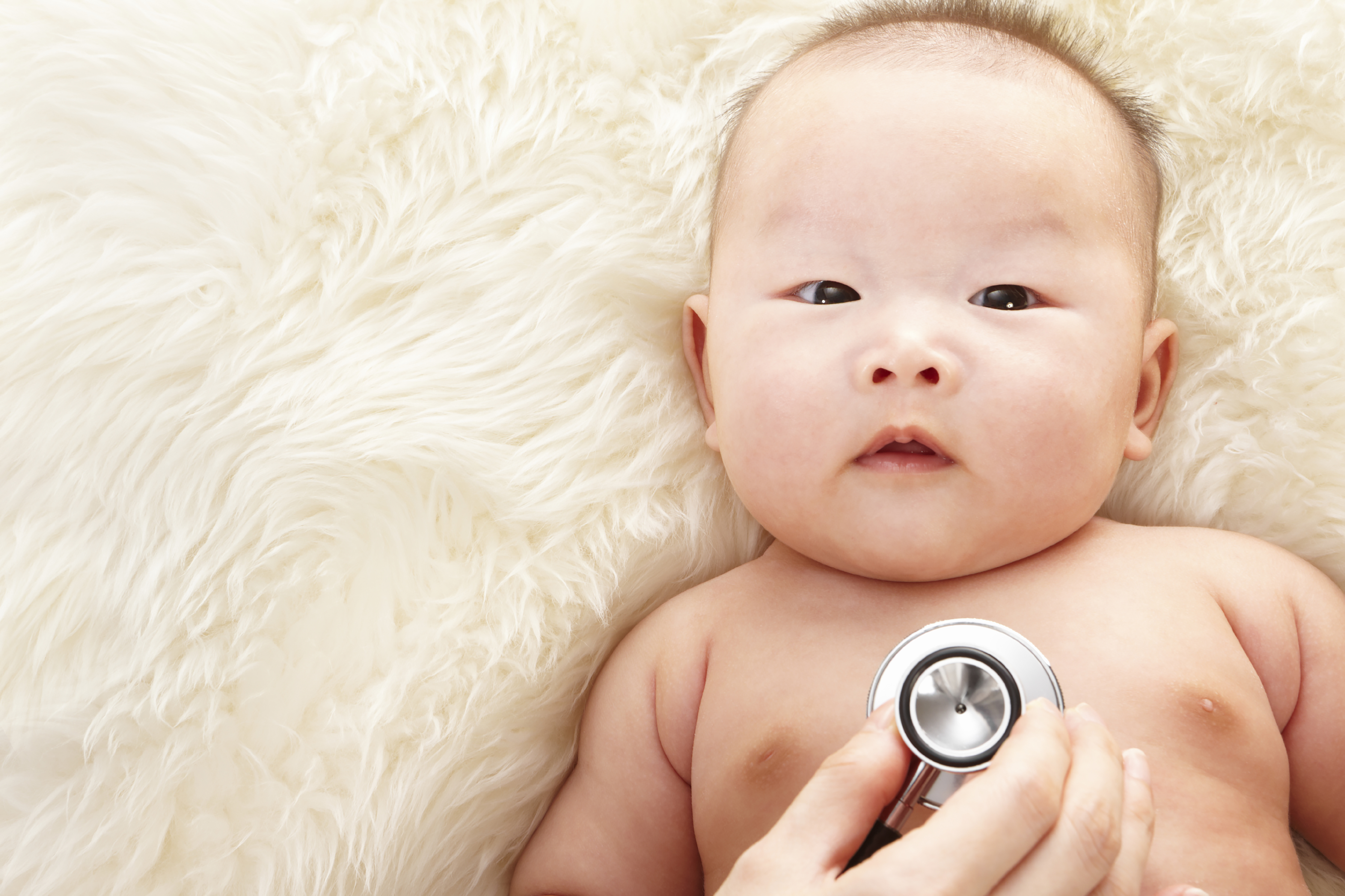Condition
Pediatric Differences in Sex Development
When a child's gender is in question at birth, because genitals may not appear clearly male or female, the child is said to have ambiguous genitalia. Ambiguous genitalia can be a confusing and scary experience for parents, but these children are usually healthy. Ambiguous genitalia is more common than most people realize.
Frequently Asked Questions
What are ambiguous genitalia?
Early in fetal development, the tissue that will become the gonads (ovaries or testes) is identical and has the potential to become either ovaries or testes, depending on the genetics of the fetus. Humans have 46 chromosomes in each cell of their body, or 23 pairs. The 23rd pair is important for sex determination; females usually have two X chromosomes, while males usually have one X and one Y chromosome.
There is a gene located on the short arm (top half) of the Y chromosome, called SRY, which, if present, will cause the gonad to become testes (indicating a male) around the sixth week of fetal life. At the same time, the tissue that would have become the female reproductive organs (uterus and fallopian tubes) will disappear. As the testes produce testosterone (male hormone), the phallus (penis), scrotum and urethra form. Later, during the seventh to eighth month of the pregnancy, the testes will descend into the scrotum.
In the absence of the SRY gene, the gonad will become an ovary (indicating a female). Likewise, the female reproductive tract will continue to develop, forming the uterus and fallopian tubes. At the same time, the tissue that would have become the male reproductive organs (epididymis and vas deferens) occurs.
Changes in a number of genetic or hormonal factors can affect this process, leading to ambiguous genitalia. Ambiguous genitalia, as the word implies, may make determining the child's gender more difficult. More recently, the term Differences (or Disorders) of Sex Development (DSD) has been used to describe conditions in which the child’s genetics, hormones, internal organs or external genitalia are atypical.
It is important to know:
- These conditions are not as rare as most think and affect about 1 in 100 newborns.
- There is a wide variety of conditions which can cause ambiguous genitalia; healthcare providers can evaluate a child's condition to determine the best course of care.
- Children with DSD can sometimes have other congenital problems, but in general these children are healthy.
- One of the more common conditions known as congenital adrenal hyperplasia needs to be diagnosed and treated soon after birth to avoid serious illness in the baby.
What causes differences in sex development (DSD)?
There are a number of different causes of ambiguous genitalia, with the most common described below. The cause, in many cases, is not known and the disorder appears to occur by chance.
Types of DSD
Children who are born with ambiguous genitalia may fall into one of the following groups:
Sex chromosome DSD
- Chromosomes can be a mixture of 45 X, 46 XX, 46 XY and 46 XXY
- Some people with sex chromosome DSD can have both ovarian and testicular tissue as well as both male and female internal organs
46 XY DSD
This entails cases where the chromosomes are 46 XY but the testes did not develop (gonadal dysgenesis), the hormones are not produced or the body does not respond or only partially responds to the hormones. These include:
- Complete androgen insensitivity syndrome:
- 46, XY karyotype
- Normal female external genitalia
- This is called androgen insensitivity syndrome because the body does not respond to androgens (testosterone). Androgen insensitivity syndrome is inherited by a defect in the androgen receptor gene on the X chromosome and the inheritance is therefore described as X-linked recessive. Mothers who carry the gene have a 50/50 chance to have a 46 XY daughter with androgen insensitivity syndrome, while 46 XX daughters (of mothers who carry the gene) have a 50/50 chance to be carriers of the gene and thus pass it on to their children
- Partial androgen insensitivity:
- 46 XY karyotype
- Can have female external anatomy, male external anatomy or have features of both
- People with partial androgen insensitivity only respond in part to androgens (testosterone)
- 5-alpha-reductase deficiency:
- 46, XY karyotype
- Genital ambiguity
- The enzyme 5-alpha reductase is deficient; therefore, it cannot carry out its task of converting testosterone into dihydrotestosterone (DHT) which is necessary for complete masculinization of a male fetus. A 5-alpha-reductase deficiency is inherited by an autosomal recessive gene, which means that each parent carries one copy of the gene and transmits it to the child. With each pregnancy, carrier parents have a one in eight (or 12.5%) chance to have an affected child since only 46 XY infants are affected
46 XX DSD
- Happens when babies are exposed to excess male hormone due to a problem in their adrenal gland because they have the SRY gene and thus developed testes or due to external exposure to male hormones while they were developing in their mother’s uterus. The most common cause of 46 XX DSD is due to congenital adrenal hyperplasia (CAH).
- About congenital adrenal hyperplasia (CAH):
- Caused by a defect in an enzyme (21-hydroxylase) in the steroid hormone synthesis pathway in the adrenal gland
- Most common cause of ambiguous genitalia in newborns
- Causes females to be masculinized due to a deficiency of the enzyme 21-hydroxylase
- Present in about one in 15,000 newborns
- Inherited by an autosomal recessive gene. Autosomal recessive means that each parent carries one copy of the gene, and transmits the gene at the same time to the child.
- With each pregnancy, carrier parents have a one in four (or 25%) chance of having an affected child. Affected females have ambiguous genitalia but affected males do not.
- In some cases, the mother of a child with CAH can be given medications during pregnancy to lessen the effects of the enzyme deficiency if the fetus is female; but this still remains experimental.
- Another type of CAH called salt-losing is very serious and often lethal due to changes in the blood levels of sodium and potassium in the newborn. Treatment is available and if diagnosed early, lethal side effects are avoided. Males and females are equally affected. There are other rarer enzyme problems which can result in CAH in either males or females.
- About congenital adrenal hyperplasia (CAH):
There are a number of other syndromes in which ambiguous genitalia is one feature (characteristic) of the disorder in addition to other features.
How is the gender determined in a child with ambiguous genitalia?
When a child's genitalia appear ambiguous at birth, your child's physician will conduct both a medical history and a physical examination of your child's external genitalia. The medical history will include the mother's health during pregnancy and a family history of any neonatal deaths or genital abnormalities. Then diagnostic procedures are performed which may include a newborn screening test for CAH, hormonal studies and an ultrasound, and genetic/chromosomal studies.
The physicians at the Positive Reevaluation of Urogenital Differences (PROUD) Clinic, formerly known as the Differences (Disorders) of Sexual Development Clinic, will work with your family to determine the best course of care for your child. In addition, the Children’s National PROUD team will provide expertise in many fields, as well as support through social work and psychology.
Providers Who Treat Differences in Sex Development
David Charles Call, MD
Locations
Departments

Daniel Paul Casella, MD
- Director, Urology Fellowship
- Medical Director, Informatics for Surgery
- Urologist
Daniel Paul Casella, MD
Locations
Departments

Veronica Gomez-Lobo, MD
- Director, Positive Reevaluation of Urogenital Differences (PROUD) Clinic
- Pediatric and Adolescent Gynecologist
Eyby Luz Leon Janampa, MD
Locations
Departments
Louise Clare Pyle, MD, PhD
Locations
Departments
Jul 22, 2024
Helping Maddie to Live Life to the FullestMaddie is a lively, creative teen who loves to act. Research at Children's National Hospital helps to ensure that her rare disease doesn"t upstage her big theater plans or her love of life.
Jun 27, 2024
Convenient Care for CharlotteWhen Charlotte was a toddler, a respiratory illness led to a diagnosis of a rare and dangerous immune deficiency called ICF syndrome. A bone marrow transplant at age 5 at Children’s National helped save her life.
May 20, 2024
Omid Conquers Fear with MusicOmid never liked going to the dentist. Dr. Aleger changed that with a little trust, and his favorite tunes.
Departments that Treat Differences in Sex Development

Prenatal Pediatrics Institute
The Prenatal Pediatrics Institute at Children’s National Hospital in Washington, D.C., provides specialized care for babies during pregnancy, delivery and after birth.

Rare Disease Institute
Children’s National Rare Disease Institute (CNRDI) is a first-of-its-kind center focused exclusively on advancing the care and treatment of children and adults with rare genetic diseases.

Gynecology Program
When your child needs specialized gynecologic care, Children's National Hospital has the experience and expertise to provide the most appropriate care for younger patients.

Endocrinology and Diabetes
Learn more about the Division of Endocrinology and Diabetes which is a nationally recognized leader in treating a variety of endocrine disorders.

Urology
At Children’s National Hospital in Washington, D.C., our pediatric urologists provide comprehensive care for disorders affecting reproductive and urinary organs.

Positive Reevaluation of Urogenital Differences (PROUD) Clinic
Children’s National Hospital Positive Reevaluation of Urogenital Differences (PROUD) Clinic, formerly known as the Differences (Disorders) of Sexual Development Clinic, provides specialized diagnostic, evaluation and treatment services for children with a variety of rare and complex diseases.

Psychiatry and Behavioral Sciences
Psychiatry and Behavioral Sciences at Children’s National offers assessment, diagnosis and care for children and teens with behavioral, emotional and developmental disorders.







